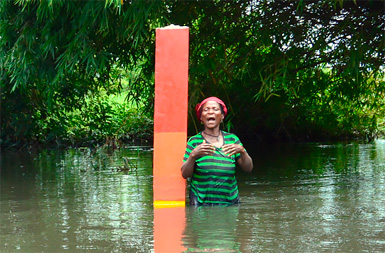
The CC-GIRE (cadre de concertation GIRE, IWRM consultation framework) are structures within which the community of interest around water can come discuss and exchange in an integrated manner. CC-GIRE structures, created or strengthened by PSL Eau, are preconfiguration structures to Local Water Committees (CLE, Comité Local de l’Eau), established by the State.

Woman standing next to an EWS beacon, with water up to the yellow mark, signaling to the community that “water is coming” and to ready for potential floods (accelerate harvesting, strengthen houses, keep an eye on children and vulnerable people). This alert will also be dispatched to people living in the area covered by this beacon.
‘The (EWS) mobile application allows anyone to give pre-alerts to local authorities at the communal and national level (through the ANPC), but also allows technical services, mayors and their deputies to provide answers to the problems of the population, and to convey real-time alerts on floods.’
Xavier CODJIA,
PSL Eau Project Coordinator
‘VNG International has taken ownership of the EWS, because today for the government, the objective is 0 death, which is the ideal, and the government is doing everything possible to achieve this objective. […] Today, people can no longer wake up in the water, because arrangements have been made for information to arrive in real time, and the communities themselves, through the structures put in place, anticipate and reduce the risk of disaster as much as possible.’
Martial DOSSOU,
National EWS Focal Point at the General Directorate for Water
More information:
YouTube playlist with PSL Eau thematic videos and short documentary
Foldable map with PSL Eau pilot sites and approaches (see enclosed)
Factsheet on EWS (English, French)
building more effective public administration by strengthening democratic local government
Featured Project
Benin, PSL Eau
In Benin, in the Lower Ouémé Valley (BVO), a territory with multiple constraints related to water, climatic risks, rampant and poorly controlled urbanization, PSL Eau has facilitated the operationalization of Integrated Water Resources Management (IWRM) through the development of synergies of concrete actions for inclusive flood management in 5 communes. With an innovative approach, the project has facilitated inclusive flood management and economic valuation of water resources, among other things by setting up multi-stakeholder consultation frameworks for the continuous sharing of good practices and the implementation of IWRM pilot actions, in order to positively impact the resilience of populations.
These initiatives of the project, with the support of various actors such as the General Directorate for Water (DG Eau), the National Agency for Civil Protection (ANPC), have helped the authorities to maintain the safety and lives of their populations, particularly thanks to the community EWS component, which now allows the communities themselves to monitor the water levels, and to report the information to the communal and national levels, for pre-alerts to be dispatched to the areas concerned. PSL Eau's contributions are therefore now part of the communal and national administrative arsenal to improve flood resilience, hand in hand with communities.
Results achieved:
The immediate effects reach approximately 148,583 people, or 97% of the population of the project intervention area.
- The reduction of losses and damages after the recent floods (2021) in the intervention area, the overall objective of the project: from 140,599 people having recorded losses or damages in 2019, there are 10% less at the end of the project in 2021;
- 136,120 people, an improvement of 136% from the initial situation in 2019, benefit from the implementation of community plans of operations for Inclusive Flood Management and Economic Valuation of Water Resources ;
- The creation of 13 functional consultation frameworks to date, and another 3 in progress, with more than 77% of active members, 51% of whom are women and youth, and the strengthening of 233 groups and organizations;
- An increase in the knowledge and capacity to deal with floods of more than 84% of people, including the use of the Community EWS;
- The central element of our intervention, the execution of pilot actions through the HIMO (High Intensity Labor) approach, has enabled 375 people, including 330 young people and 45 women, to benefit from jobs;
- Recovery of a total of 5362 hectares of cultivable land after drainage of water, including 3950 hectares of agricultural land;
- 25 capitalization products have been created and disseminated, thanks in particular to digital communication through a WebTV.
The results undeniably show that the project's intervention areas have increased their level of resilience, especially the rural areas, which now have a high degree of stability in their agricultural and livestock production. The various results obtained call for the continuation of the implementation of pilot actions in order to further strengthen the grassroots populations on the adoption of good resilience practices.